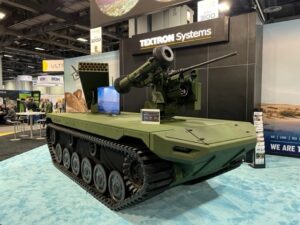The Army has selected Textron Systems [TXT], General Dynamics Land Systems
[GD], Oshkosh Defense [OSK] and McQ Inc. for the first phase of its Robotic Combat Vehicle (RCV) competition, with each tasked to deliver two prototype platforms by next August.
The four firms were awarded a combined total of $24.7 million for phase one of the RCV program, before the Army ultimately selects one company in fiscal year 2025 to deliver nine prototypes and makes a production decision in FY ‘27.

“This marks the official transition for us out of experimentation and movement to a fieldable RCV platform prior to 2030,” Steve Herrick, the Army’s RCV product manager, said in a statement on Wednesday.
The Army kicked off its search for RCV prototype proposals in late March, which followed testing the last few years with surrogate prototype vehicles in light and medium variants, to include a solution from QinetiQ and Oshkosh Defense’s Pratt Miller, to help inform requirements for the competition (Defense Daily, March 29).
Doug Bush, the Army’s top acquisition official, confirmed in July 2022 the Army plans to move ahead for now with a focus on developing the light variant as its main RCV effort (Defense Daily, Aug. 3 2022).
“The RCV-Light will deliver increased situational awareness, lethality, and tactical options for Army formations in support of multi-domain operations. Its operators will remotely control RCVs or task them to operate semi-autonomously. Variants will serve as ‘scouts’ or ‘escorts’ for manned fighting vehicles,” the Army said in its announcement on Wednesday.
While the four firms work on building RCV prototypes over the next year, the Army said the vendors will “concurrently mature and deliver integrated system designs towards Army requirements for a lightweight, modular, and upgradeable robotic combat vehicle.”
Textron has previously detailed its Ripsaw M3 offering for RCV with a team including its Howe & Howe subsidiary and Teledyne FLIR [TDY], the latter providing a 360-degree situational awareness system and the operator control interface for the platform (Defense Daily, June 7).
The Ripsaw M3 weighs 18,000 pounds, a 13,000-pound curb weight and 5,000 pound payload capacity, which is below the Army’s 21,000 pound requirement for RCV, has 63-square feet of flat deck space for payload integration, features a hybrid-electric drive design and can reach speeds above 30 miles per hour, according to Textron.
GD Land Systems has pursued RCV with its Tracked Robot X-Ton, or TRX, robotic vehicle, to include previously showcasing the platform with different payloads ranging from resupply, fires, loitering munitions and breacher and SHORAD configurations (Defense Daily, March 23).
“The TRX offers an innovative solution for some of the Army’s force structure challenges and, more importantly, addresses many of the dirty, dull and dangerous missions with an innovative multi-payload-capable suite of robotic combat vehicles,” Scott Taylor, GD Land Systems’ director of U.S. business development, previously told Defense Daily.
Pat Williams, Oshkosh Defense’s chief program officer, told Defense Daily in March the company’s participation in the initial surrogate testing phase informed the company’s proposal for the RCV prototyping program.
“They give the soldiers the capability to go and play with it and to use it in operational scenarios. They got that soldier feedback to inform the design and the requirements for how it will eventually be employed. So that is what’s been going on for the last couple of years,” Williams said at the time. “We’ve got a couple of years now of no-kidding hands-on testing with our government customer and the soldiers that’ll inform our design for what we propose for this RPP (Request for Prototype Proposals).”
Fredericksburg, Virginia-based McQ Inc. describes itself as a “small agile business…spearheading the art of ground sensor and satellite communications systems, providing solutions for difficult remote monitoring and surveillance applications,” while details are not currently public on its RCV offering.
BAE Systems, which was not selected for the RCV prototyping effort, said in March it was interested in the program, with Jim Miller, the company’s vice president of business development, telling reporters at the time it had “four or five designs” it could respond with to the RPP.
“We are interested in all things autonomy and all things RCV. So the answer is yes, we are very interested,” Miller said. “We are looking at pursuing. There’s a business decision that has to be made.”
BAE Systems previously unveiled its Robotic Technology Demonstrator platform in October 2019 (Defense Daily, Oct. 15 2019).
The Army’s multi-phase effort for RCV will include selecting one of the four firms in FY ‘25 for a second phase to deliver nine prototypes, to be followed by the production decision in FY ‘27 and an aim to field the platform to a first unit in FY ‘28.